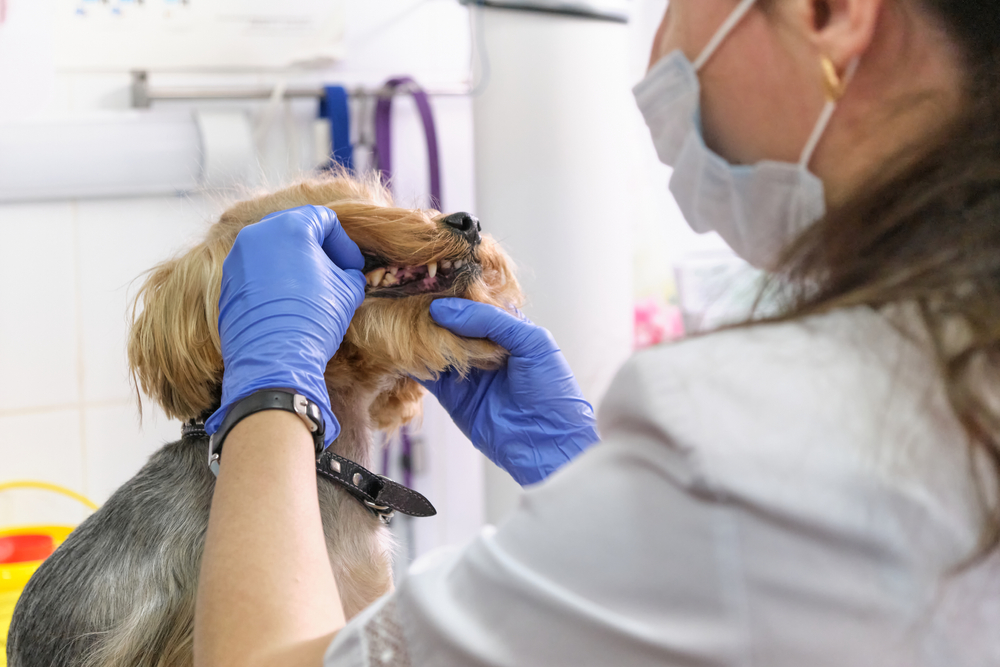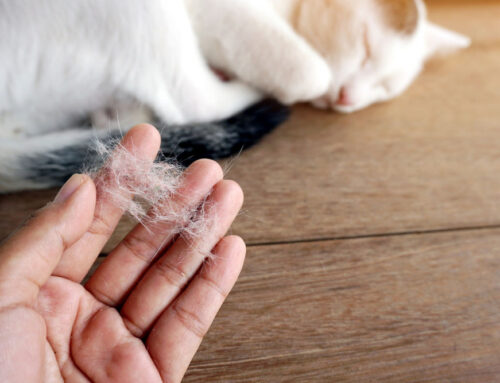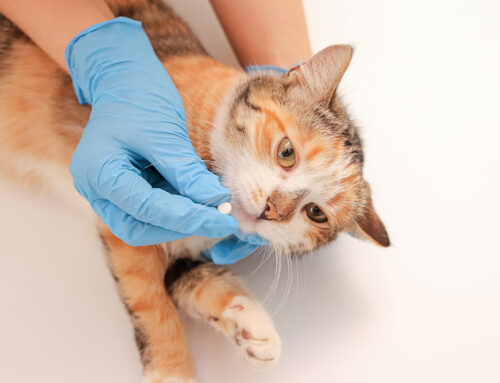Dental disease is one of the most common medical conditions seen by veterinarians, and only a professional veterinary dental cleaning can effectively address the problem. February is National Pet Dental Health Month, and to raise awareness about this important issue, our WesVet Animal Hospital team follows Missy, a 5 year old Pekingese, as she has a professional veterinary dental cleaning, so you can see what this procedure involves.
Missy arrives at the veterinary practice
Missy is a friendly dog, and she makes her rounds, saying “Hello” to the veterinary team and allowing everyone to pet her and give her treats. Once she has met her social duties, our veterinary team checks her over to ensure she is a good candidate for the procedure. She passes her physical examination with flying colors! The next step is to pull a little blood, which Missy tolerates with great courage. Her complete blood count (CBC) and biochemistry profile are normal, so we tell her owner that we can proceed with the dental cleaning.
Our veterinary team anesthetizes Missy
Missy is an extremely well-behaved dog, but a professional dental cleaning is best performed under general anesthesia. This not only allows our team to perform a more thorough job, but also means that Missy, because she is anesthetized, is less likely to be stressed or injured by the sharp instruments that we will use to evaluate and clean her teeth. A team member is assigned to monitor Missy throughout the procedure until she is recovered, and we take every precaution to ensure she has the safest experience possible.
Our veterinary team takes dental X-rays
Dental X-rays provide valuable information about Missy’s oral health by allowing our team to visualize her tooth roots, bones, and other supporting structures below the gum line. Dental X-rays can also help us detect other serious conditions, such as:
- Tooth root abscesses
- Tooth fractures
- Dead teeth
- Tooth resorption lesions
- Bone loss
- Jaw bone fracture
Missy’s X-rays look OK, but she has one tooth root on the lower right side that is deteriorating.
Our veterinary team evaluates Missy’s mouth
Now it’s time to examine Missy’s mouth. We first notice that she has pretty offensive breath, which is not surprising, because the majority of pets older than 3 are affected by dental disease, and one of the most common signs is halitosis. We carefully evaluate Missy’s lymph nodes, salivary glands, and mucosal tissue and find no abnormalities. However, her gums appear swollen, and her teeth show a significant amount of tartar. We evaluate each tooth for mobility, discoloration, fractures, and periodontal pockets with a probe, and notice that Missy’s gums have started to bleed. Plus, the tooth that exhibited root deterioration on X-rays is discolored and extremely loose. We speak with Missy’s owners and decide to extract the tooth to prevent pain and further complications. The tooth comes out cleanly, and we find no other teeth that need advanced care.
Our veterinary team cleans Missy’s teeth

During the oral exam, we noticed that Missy had extensive tartar accumulation on her teeth. These deposits occur when the oral bacteria form a sticky matrix called plaque. If not removed, the minerals from Missy’s saliva will cause the plaque to harden into tartar, a rough, gritty substance that irritates the gingiva and allow bacteria to invade under the gum line where the pathogens damage the supporting teeth structures. Potential complications include loose teeth, tooth root abscesses, and bone loss leading to jaw fracture. In addition, the bacteria can enter the bloodstream and damage organs such as the heart, kidneys, and liver. Next, we use ultrasonic tools and hand-held scalers to remove the tartar from Missy’s teeth, and to clean beneath her gum line.
Our veterinary team polishes Missy’s teeth
After irrigating Missy’s mouth and ensuring we have removed all debris, we polish Missy’s teeth to remove the microabrasions left by the cleaning process, which helps discourage bacteria from adhering to her teeth. We also apply fluoride to help reduce plaque and tartar accumulation.
Missy goes home with her parents
Once Missy is fully awake, she is ready for discharge. We spend time with her owners explaining our findings, and send them home with antibiotics and pain medication for Missy, because we extracted a tooth. We also recommend a comprehensive dental care plan for Missy, which includes:
- Reassessment — Most pets need a professional veterinary dental cleaning about once a year, but Missy is a flat-faced (i.e., brachycephalic) breed, which puts her at higher risk for dental disease. Our team recommends reassessing her oral health in six months to ensure she doesn’t lose more teeth from dental disease.
- Daily toothbrushing — We suggest that once Missy’s mouth has healed, her parents start brushing her teeth daily to remove plaque that accumulates between professional veterinary visits. Since Missy is small, a small fingertip brush will likely be best. We also advise her owners to purchase pet-specific toothpaste, since human dental products can be dangerous for pets.
- Dental treats — Dental treats can help remove plaque and tartar, and we recommend Veterinary Oral Health Council (VOHC)-approved products.
At Missy’s six month assessment, her mouth looked great, and her owners remain vigilant in brushing her teeth daily—she loves her beef-flavored toothpaste, they said.
If your pet’s breath is less than fresh, contact our WesVet Animal Hospital team to schedule a professional veterinary dental cleaning to help promote your pet’s oral hygiene and general health.







Leave A Comment